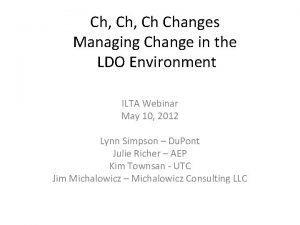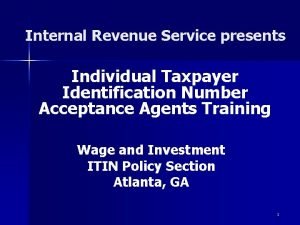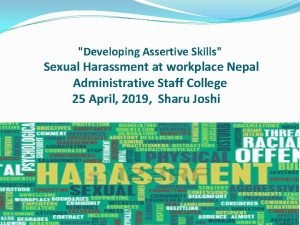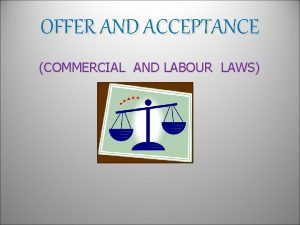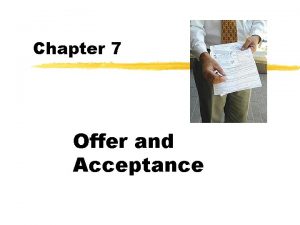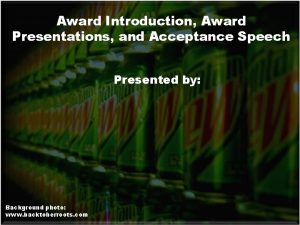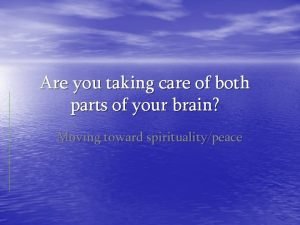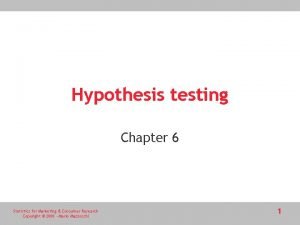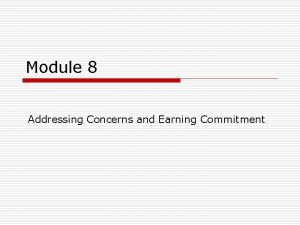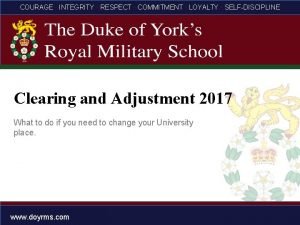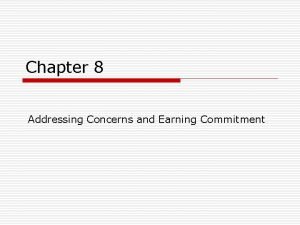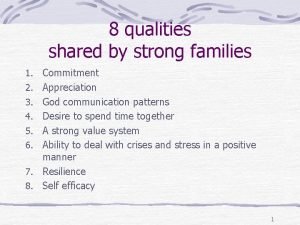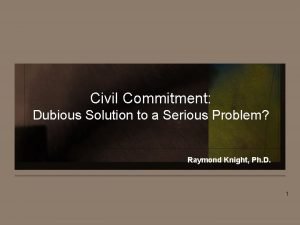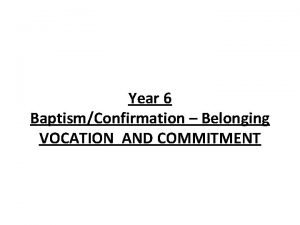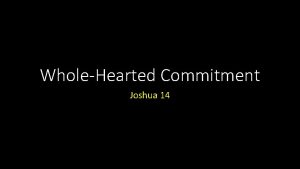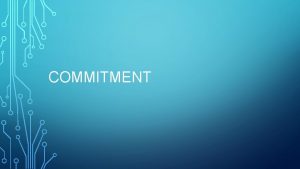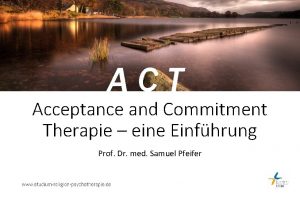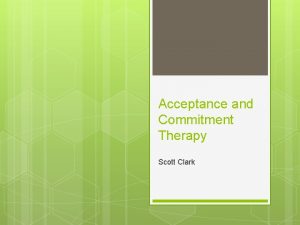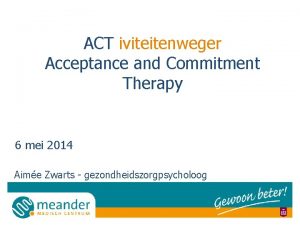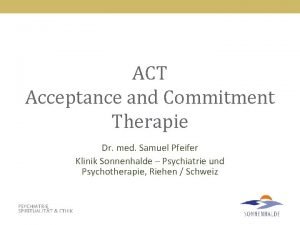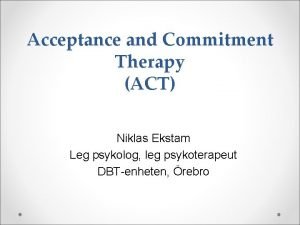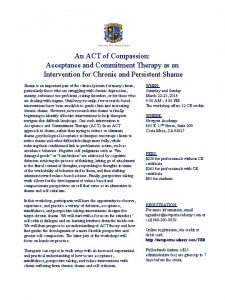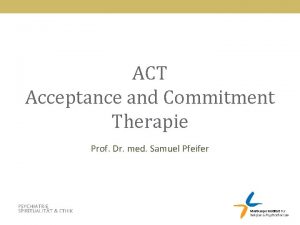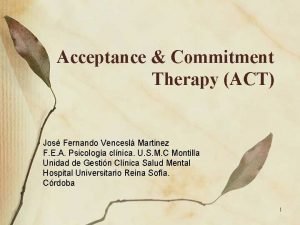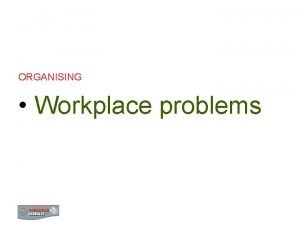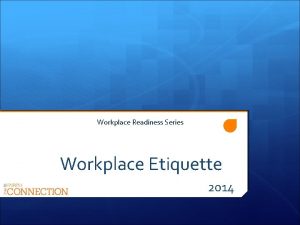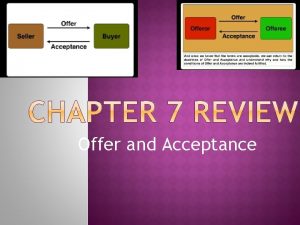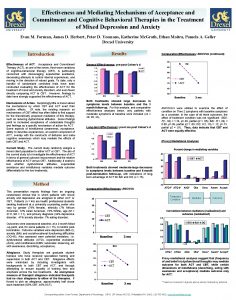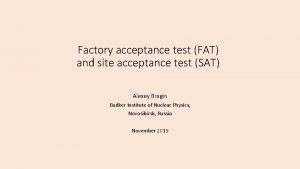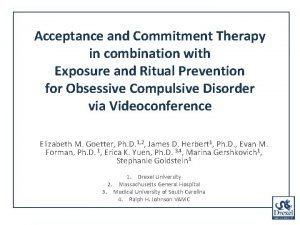Acceptance and Commitment Training ACT in the Workplace





































- Slides: 37

Acceptance and Commitment Training (ACT) in the Workplace A Three-Session Protocol Dr. Paul Flaxman City University London 11 th March 2011

Acknowledgements Funders • City University Staff Development Unit • Economic and Social Research Council • Guy’s and St. Thomas’ Charity Collaborators • • Prof. Frank Bond Jo Lloyd Mia Soderberg Dr. Vasiliki Christoloudou Dr. Matthew Wardley Dr. Joe Oliver Eric Morris

Presentation Overview • Background ØEvolution of the ACT at Work protocol ØWhy the workplace is a good place for ACT • Overview of the three sessions • Adopting the ACT stance • Implementation issues Q&A

Evolution of the ACT at Work Protocol How I got started: ACT working manual (1995); Frank’s ACT for stress protocol; ACT book (1999) This stuff is confusing How can I make it my own? How can I translate this for the general public?

Evolution of the ACT at Work Protocol 2002 -2004: Three-session ACT training for local council employees (N ~ 500+) 2007 -2008: Brief ACT sessions for Central Government employees (N ~ 60) 2008 -2009: One day ACT sessions for University staff and students (N ~ 200) 2009 -2010: Updated three-session ACT for NHS and central government workers (N ~ 250) 2009: Commissioned by New Harbinger to publish threesession protocol

Why the workplace is a good place for ACT 1 in 6 UK workers experiencing a common mental health problem at any one time…. . 75% of whom do not receive psychological intervention (Seymour & Grove, 2005) Let’s take the interventions to them!

Why the workplace is a good place for ACT Presenteeism costing businesses ‘ 1. 5 to several times’ more than absenteeism (Sainsbury Centre, 2007) Helping people function better while experiencing difficult private events

Why the workplace is a good place for ACT Experiential avoidance viewed as a basic vulnerability factor (or ’transdiagnostic’ process) Workplace highlighted as a viable context for preventive intervention (Biglan et al. , 2008)

A Three-Session Protocol

My ‘top tips’ • Don't try to do too much – less is sometimes more (cf. Richardson & Rothstein, 2008) • Use simple organising strategies • Do away with the ‘gloss’ • Focus on cultivating the 6 core processes, rather • Use humour (e. g. , two core skills; Passengers on the Bus) – let the processes sell themselves and allow your humanity to shine through! than any strict ordering of techniques

Session 1 – Opening • Hopes and expectations • Ground rules (confidentiality etc) • Other support available • Training, not therapy • Importance of attending all sessions • Introduction to the training….

Introduction MINDFULNESS Present moment awareness training Untangling from difficult thought and emotion Finding your resilient sense of self VALUES-BASED ACTION Clarifying your most valued life directions Using values as a guide to goals and daily behaviour

Introduction RATIONALE (each point open to discussion) • Humans are dealing with two worlds: inside the skin and outside the skin • We can sometimes become overly ‘entangled’ with particular thoughts and feelings • ‘DIFFICULT’ THOUGHTS AND FEELINGS CAN INTERFERE WITH OUR ACTIONS/ BEHAVIOURS/ GOALS

Mindfulness Introduction • Developing greater present moment awareness • Noticing the difference between: • • Being ‘lost’ in thought, and • Aware of thoughts coming and going Taking a non-judgemental view of all thoughts, feelings, and sensations

Linking mindfulness and valuesbased action Let’s look at why we will be practicing these rather strange exercises – to start revealing the purpose of this training: 1. Benefits of mindfulness 2. To ensure that our own thoughts and feelings do not interfere with our chosen life directions and goals

Passengers on the bus about here!

Passengers on the Bus While fighting / arguing with/ trying to remove the unwanted passengers seems the sensible thing to do. . . • Do the unwanted passengers get off and stay off the bus? • What’s happening to the bus while we are back there fighting/ arguing with the passengers? • Does engaging with the passengers make them more or less important in our lives?

The Bus of Life Exercise For one important area of your life: 1. Identify the most important chosen direction for your bus service (values) 2. Identify a few bus stops along the way (goals) 3. Identify the very next turn (tonight/ tomorrow/ this week) (actions) 4. Identify any passengers (thoughts, feelings, memories, urges etc) that have the potential to ‘hijack’ your bus (internal barriers)

Theory bit Inside the skin/ outside the skin distinction (Undermining experiential avoidance)

More mindfulness/ acceptance work What is the alternative to fighting/ arguing/ debating/ suppressing these passengers? • ‘Untangling’ from them • Getting a bit of distance between you and your passengers • Seeing them for what they actually are **Physicalizing exercise about here**

Session 1 Homework • Bring present moment awareness to your journey to work each day • Mindfulness of breathing (10 mins each day) • Complete the Bus of Life exercise across five life areas Start to get a good sense of: 1) Your chosen values, goals, actions 2) Any ‘difficult’ or ‘unhelpful’ passengers that want to control your bus

ACT Stance Focused on the core processes from the outset. . . Trainer: Does anyone else have any hopes or expectations about what you might get from these three sessions? Participant: I’d love to learn something that would help me to stop worrying and going over and over things in my head. Trainer: Right. So your mind loves a good worry? Participant: It sure does. You name it, I’ll worry about it!

ACT Stance Trainer: Neat. We’ll have a good look at that in these sessions; worrying is one thing minds are very good at! My mind is the same – it loves a good old worry. Anyone else’s mind do something similar? (all but one person in the group raised their hands)

ACT Stance After a physicalizing exercise. . . Trainer: Did anyone notice a feeling or sensation pop up? Participants: I certainly did. It was like a sense of dread or foreboding. Trainer: Great. Nice. And where in your body did you experience that?

ACT Stance Participant: Right in the pit of my stomach – like a burning sensation and a feeling of heaviness Trainer: Good stuff - you've really noticed it. And did it take on some shape and form as if it were a physical object. . . ?

Session 2 (one week later) Session aim: Strengthening the two core skills • Mindfulness of breathing/ body (5 to 10 mins) • Mindfulness homework review (brief) • Values homework review (additional coaching around values, goals, and actions)

Defusion Did anyone find that their ‘Mind Chatter’ interfered with values-directed action? Anything your Mind ‘says’ that causes you to stop the bus or move in a less valued direction? So, let’s look at a couple of exercises that help to ensure YOU are the driver. .

Defusion “I’ll do it tomorrow” “Why should I, he doesn't really deserve it” “I’ll probably do it wrong” I’m having the thought that. . . “I’ll do it tomorrow” I’m having the thought that. . . ”he doesn't really deserve it” I’m having the thought that. . . ”I’ll probably do it wrong”

Defusion Also works with the ‘feeling’ passengers: It’s embarrassing I’m having a feeling of. . embarrassment I was too stressed I was having a feeling of. . stress I was having a bodily sensation of. . a knot in my throat and chest A use of language that establishes some healthy distance between you – a conscious human being – and your internal experiences

Defusion Let’s take a look at these thought passengers for what they actually are: **Milk exercise here** Quickly followed by other thought barriers that came up “tomorrow”, “wrong”, “no time”, “danger” etc And we let this control our actions, and therefore our life? !

Defusion Also useful to start glimpsing thoughts as they come and go Noticing those moments when we get hooked by a particular thought ***White Screen OR Leaves on the Stream OR Soldiers in the Parade here***

Self-as-context There’s a highly resilient and stable part of you being used and slowly revealed here • From where were you observing your thoughts just now? • Who was noticing your breathing? The observing self: • A perspective that we don't often use • You find it every time you practise a mindfulness exercise • A place that is unharmed by difficult thoughts and feelings

Final values clarification, goal and action planning Step 1: Pick one of your most important values – see if you can capture it in just a few words Step 2: Identify short-term, medium term, and long-term behavioural goals that would help you pursue that direction Step 3: Choose the next action that will get you moving down that valued path

Taking a stand Each person stands, states the value, along with the next values-based action

Session 2: Homework • Consider the next few weeks as the testing ground for cementing these two core skills • Four week schedule of mindfulness practice (supported by CD) • Values-based goal and action planning sheets Pursuing valued actions will surely give rise to potential internal barriers for you to work on

Session 3 (1, 2, or 3 months later) • Cementing the two core skills • Mindfulness practice and check-in • Bull’s eye exercise • Additional defusion work on barriers • Physicalizing exercise or Tin Can Monster • Taking a stand on most important valued direction for the rest of this year

ALL ABOARD! Thank you for listening!
 Change curve+awareness+understanding+acceptance+commitment
Change curve+awareness+understanding+acceptance+commitment Form 13551 instructions
Form 13551 instructions Bullying and harassment training resources
Bullying and harassment training resources Sexual harassment at workplace act nepal
Sexual harassment at workplace act nepal Act 1 act 2 act 3
Act 1 act 2 act 3 Offer and acceptance
Offer and acceptance Offer and acceptance
Offer and acceptance Acceptance house
Acceptance house Functions of inspection and acceptance committee
Functions of inspection and acceptance committee Circle of sexuality
Circle of sexuality Divestment in consumer decision process
Divestment in consumer decision process Award introduction speech
Award introduction speech And acceptance is the answer to all my problems
And acceptance is the answer to all my problems Acceptance and rejection region
Acceptance and rejection region Post-approval stability protocol and stability commitment
Post-approval stability protocol and stability commitment Addressing concerns and earning commitment
Addressing concerns and earning commitment Denotation and connotation of player
Denotation and connotation of player Discipline integrity and commitment
Discipline integrity and commitment Addressing concerns and earning commitment
Addressing concerns and earning commitment Building commitment
Building commitment Intimacy and passion without commitment
Intimacy and passion without commitment Quality statement examples
Quality statement examples Pros and cons of civil commitment
Pros and cons of civil commitment Vocation and commitment
Vocation and commitment Commitment denotation and connotation
Commitment denotation and connotation Commitment in health and social care
Commitment in health and social care Brutal denotation
Brutal denotation Hát kết hợp bộ gõ cơ thể
Hát kết hợp bộ gõ cơ thể Frameset trong html5
Frameset trong html5 Bổ thể
Bổ thể Tỉ lệ cơ thể trẻ em
Tỉ lệ cơ thể trẻ em Voi kéo gỗ như thế nào
Voi kéo gỗ như thế nào Thang điểm glasgow
Thang điểm glasgow Chúa yêu trần thế
Chúa yêu trần thế Môn thể thao bắt đầu bằng chữ đua
Môn thể thao bắt đầu bằng chữ đua Thế nào là hệ số cao nhất
Thế nào là hệ số cao nhất Các châu lục và đại dương trên thế giới
Các châu lục và đại dương trên thế giới Cong thức tính động năng
Cong thức tính động năng
